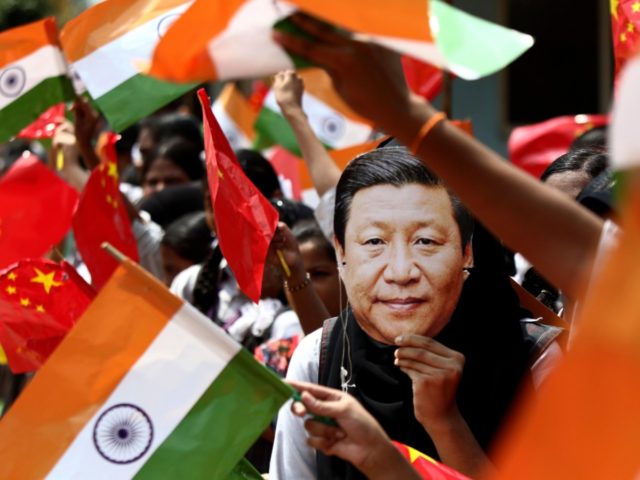Indian news sources reported on Wednesday that as many as 50 Chinese People’s Liberation Army (PLA) fighters died in an hours-long brawl between the two countries’ border soldiers on Monday. China has admitted only to “casualties” without providing a number.
Both New Delhi and Beijing claim the other side’s forces triggered the confrontation, in which soldiers reportedly beat each other with rocks, clubs, and their fists for as much as eight hours, some killing by using the difficult and steep Himalayan terrain around them. Multiple reports indicate that many of the casualties were caused by hand-to-hand combat, falls from high cliffs, and hypothermia.
Indian government officials have confirmed that at least 20 of their troops were killed and several others are in critical condition, suggesting the death toll may rise. Indian reports claim PLA soldiers “hunted down” their Indian counterparts to kill them even as they retreated into undisputed territory.
The incident occurred amid rising tensions on the “Line of Actual Control” (LAC), the technical name for the strip of border between India and Chinese-occupied Tibet in the Ladakh region. Chinese and Indian forces regularly accuse each other of illegally crossing the border, typically resulting in mild skirmishes resolved through the two nations’ foreign ministries. Last week, diplomats from both sides issued a statement claiming they had reached a “peaceful” resolution on LAC tensions.
The Times of India, citing “official sources … quoting U.S. intelligence reports,” said on Wednesday that China suffered between 35-50 casualties, which includes both killed and wounded. The newspaper noted that separate sources only said that China suffered “proportionate” casualties to those of India.
India’s News18 reported, citing a separate unnamed “senior government official,” that at least 23 Indian soldiers were killed in the battle, but as many as 110 have needed medical attention in the aftermath of the incident. “At least two dozen” Indian soldiers, the report continued are facing “life-threatening” injuries. News18 added that, on the Chinese side, “over 40 PLA soldiers may have also been killed or injured.”
The Indian military confirmed 20 deaths on their side. China has refused to provide an official number. Reported casualties on Wednesday are far higher than the three Indian troops initially reported dead on Tuesday.
Hu Xijin, the editor-in-chief of the Chinese government propaganda newspaper Global Times, used his Twitter account to claim that Beijing would not confirm any Chinese casualty counts as a gesture of “goodwill” to India, to prevent “avoid stoking public mood.” The remark suggests Chinese casualty counts are high and would enrage the Chinese public into demanding war.
Hu also claimed that many of the Indian soldiers who died did so as a result of not being evacuated quickly enough from the frigid Ladakh region, not as a result of wounds from clashes. That comment contradicts what News18 sources reported – that Indian troops had to wait for the PLA to hand back the bodies of several soldiers that allegedly ended up on the Chinese side of the border.
Hu regularly uses Twitter despite the fact that the Communist Party bans Chinese citizens from the platform.
According to Indian media reports, the confrontation occurred in the Galwan River valley, triggered by Chinese troops raising a tent within Indian territory and refusing to leave. When Indian troops approached them, the PLA soldiers refused to move, resulting in Indian soldiers burning down their tent, according to News18.
In a statement on Wednesday, Prime Minister Narendra Modi placed the blame for the incident squarely on Chinese troops.
“I would like to assure the nation that the sacrifice of our jawans will not be in vain,” he said, referring to the dead Indian soldiers. “For us, India’s unity and sovereignty is the most important and no one can stop us from protecting it. No one should have a doubt on this point. India wants peace but is capable of a befitting reply in every circumstance.”
Chinese dictator Xi Jinping has remained silent throughout the affair and has not appeared in public. Instead, Beijing has sent out various lower-level representatives to offer its version of the story.
A spokesperson for the PLA Western Theater Command claimed that India, not China, crossed the border illegally in remarks Tuesday.
“China has always maintained sovereignty over the Galwan Valley region, and the words of Indian border defense troops are inconsistent and seriously violate the agreements both countries have reached, seriously infringe upon the consensus made in the army commander-level talks and seriously harm the relations of the two militaries and the sentiment of the people in both nations,” the spokesperson, Senior Colonel Zhang Shuili, said, according to the Global Times propaganda outlet.
Zhao Lijian, the Chinese Foreign Ministry spokesman responsible for the unsubstantiated conspiracy theory that the U.S. Army caused the Chinese coronavirus pandemic, also condemned India, claiming that its troops “crossed the border twice to conduct illegal activities and launched provocative attacks against Chinese personnel,” without providing further details.
The Times of India noted that the incident was the deadliest conflict between the two countries since 1967. During a clash that year in Nathu La, Indian troops killed over 300 PLA soldiers, losing 88 Indian troops.
The tensions at the border between the two countries have escalated significantly since India announced it would establish a billion-dollar subsidy program to lure multinational corporations out of China and into Indian manufacturing. Indian officials have boasted that manufacturing in India would be easier to manage without communist totalitarian laws in place and have attempted to leverage the Chinese coronavirus pandemic to show that Beijing is an untrustworthy business partner.
Apple announced in October it would begin manufacturing iPhones in India. In May, the American company reportedly decided to move a “significant” amount of manufacturing out of China into India.
Follow Frances Martel on Facebook and Twitter.

COMMENTS
Please let us know if you're having issues with commenting.